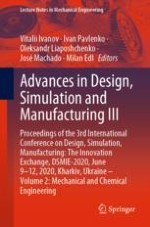This book explores topics at the interface between mechanical and chemical engineering, with a focus on design, simulation, and manufacturing. Covering recent developments in the mechanics of solids and structures; numerical simulation of coupled problems, including wearing, compression, detonation and collision; and chemical process technologies, including ultrasonic technology, capillary rising process, pneumatic classification, membrane electrolysis and absorption processes, it reports on developments in the field of heat and mass transfer, energy-efficient technologies, and industrial ecology. Part of a two-volume set based on the 3rd International Conference on Design, Simulation, Manufacturing: The Innovation Exchange (DSMIE-2020), held on June 9-12, 2020, in Kharkiv, Ukraine, this book provides academics and professionals with extensive information on the latest trends, technologies and challenges in the field as well as practical lessons learned.
